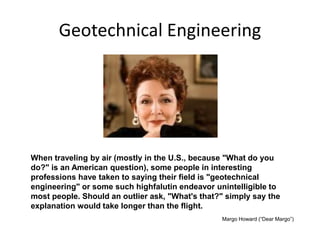An Unbiased View of Geotheta
An Unbiased View of Geotheta
Blog Article
9 Simple Techniques For Geotheta
Table of ContentsThe Definitive Guide to GeothetaHow Geotheta can Save You Time, Stress, and Money.All about GeothetaNot known Details About Geotheta
They collaborate with civil designers, structural engineers, engineers, and various other experts to integrate geotechnical considerations right into the general job style and construction procedure. This requires reliable synergy, sychronisation, and interaction to make certain that the geotechnical elements straighten with the task goals and satisfy regulative requirements.Mining & Materials Design: Concepts of boring, penetration prices, and aspects impacting the selection of exploration approach. Qualities of nitroglycerins, firing systems and blast patterns. Blasting techniques in surface and underground operations. Special blowing up strategies at excavation perimeters. Resonance and noise control. Mechanical and constant strategies to fragmentation, consisting of longwall shearing and fullface boring.
Modelling of piece and bit size circulations; comminution as a transfer feature. Comminution technology: squashing, grinding, size classification. Integrated analysis of fragmentation and comminution procedures. Offered by: Mining & Materials Design.
What Does Geotheta Mean?
Bachelor's level programs in civil, geotechnical, geological, and environmental design usually last 4 years and include general education programs in English, social science, and the humanities, in addition to courses in innovative maths, structural geology, and liquid mineralogy. (https://canvas.instructure.com/eportfolios/3071866/Home/Why_Geotechnical_Engineers_Are_Essential_for_Your_Construction_Projects)
Geotechnical design includes the assessment of the dirt and rock conditions at a certain site, and their implications for the development of that website. As the majority of frameworks rely on the ground for support, it lacks shock that an in-depth understanding of the ground problems, and the viability of structure systems, are crucial to the long-term stability and efficiency of the structure or structure.
Being experts in the investigation of geological developments and ground behaviour, geotechnical designers carry out scientific examinations and testing to comprehend the influence these geological formations might carry the layout and building of structure, civil and infrastructure tasks. This proficiency is crucial for the design and building and construction of buildings, roadways, tunnels, dams, bridges, and water supply and sewer systems.
The geotechnical group at Douglas Partners consistently seek advice from engineers, style designers, programmers, and home builders to make referrals on design and advancement proposals to ensure that the built frameworks are suitably created for the ground problems. As an example, the layout of footing systems needs to consider the weight of the structure, the capability of the ground to sustain that weight along with activity tolerances and effective building.
The smart Trick of Geotheta That Nobody is Talking About
This task is greatly simplified by the use our Douglas Map geospatial system that makes this info readily accessible in an easy to make use of internet internet browser interface. A geotechnical designer will direct the exploration of boreholes and examination pits to accumulate soil and various see here other examples, and additionally examine surface attributes and ground exposures to develop a geotechnical design of the subsurface problems.
Depending upon the job type and ground conditions experienced, laboratory screening might amongst other points evaluate strength, compressibility, sensitivity and/or leaks in the structure of soil and rock samples. Hereafter information is gathered and collated, the outcomes are made use of for a geotechnical version of the website, which is usually offered as areas across the website.

A geotechnical examination naturally can just analyze the ground problems at the locations drilled or dug deep into. Natural variants in soil and rock conditions can happen throughout a website and between test areas. It is consequently good technique that the geotechnical designer be kept throughout building and construction of the project to supply on-site verification that the ground problems encountered are consistent with the expectations and suggestions supplied in the geotechnical examination record.
See This Report on Geotheta
Geotechnical designers use their in-depth knowledge of dirt and rock to examine risk and fix problems on diverse facilities projectsGeotechnical design is a specialist branch of civil engineering which looks at the practices of earth materials and the application of dirt and rock technicians. Tailings Engineer. As a geotechnical designer, you will evaluate the physical, mechanical and chemical buildings of dirt and rock in order to develop foundations, maintaining structures and earthworks
Geotechnical design is closely linked to and overlaps with, both engineering geology and ground design - https://www.tripadvisor.in/Profile/geotheta1. It's feasible to specialise in geotechnics or help a geotechnical firm yet be referred to as a design geologist or a ground engineer. As a geotechnical designer, you'll need to: develop and maintain relationships with customers and various other experts associated with the website, throughout each projectmaintain safety and security standards on website bear in mind price ramifications when you make recommendationsstudy geological maps and aerial pictures from a series of sources and from various time periodsexamine building prepares to see how practical they are based on your understanding of the siteinvestigate risks or geological dangers for the sitesearch for environmentally delicate functions, such as garbage dump start to develop accurate and interpretive ground modelsplan area investigationsdrill and analyse samples of bedrock, dirt, groundwater and additional materials manage other professionals on sitesolve technical concerns as they occur, such as unanticipated structures at drill sitesmonitor conditions throughout and after building and construction to see to it structures are stable in the brief and long termadding information gathered on website to your initial researchcreating geotechnical computations, drawings, and 2 or three-dimensional computer designs translating the datamaking referrals about the suggested use the site

Report this page